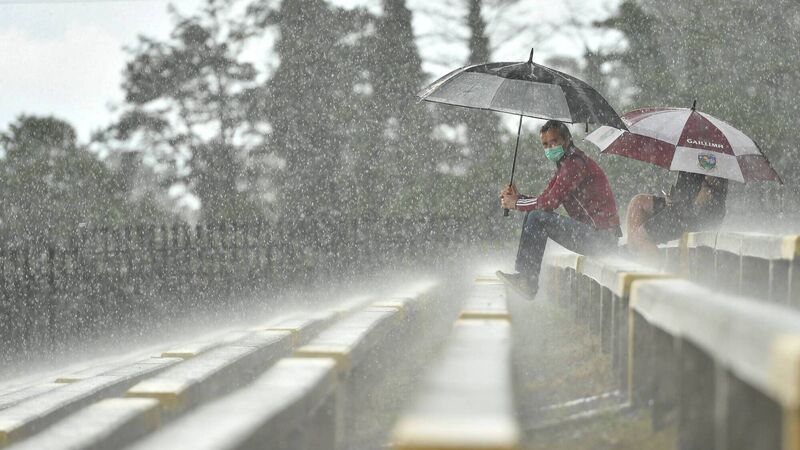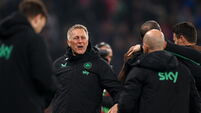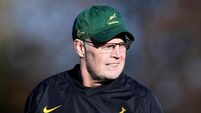Michael Moynihan: The ankle is finally having its moment

UNDER COVER: Galway supporter Des Casey from Ballybane shelters from the rain before yesterday’s Connacht SFC semi-final against Roscommon at Dr Hyde Park. See report on Pages 16-17. Picture: Sam Barnes/Sportsfile
Wimbledon is on at the moment, but don’t take that as an excuse to roll your eyes and move on.
I’m not about to bombard you with lengthy recollections of the great days of Borg and McEnroe and the rest — running outside to the eternal sunshine of the late 70s, happy to blast a not-so-fuzzy Dunlop back and forth over the gate (see? It’s hard to stop when you get started).
What caught my eye last week was the number of ankles suffering at Wimbledon, a matter of some importance to me.
Serena Williams had to retire after just six games of her match with Aliaksandra Sasnovich — she aggravated a hamstring issue when she went over on her ankle and, despite extensive medical treatment, just couldn’t keep going.
She wasn’t the only one to come a cropper. On the same day — at Centre Court, the same venue — Adrian Mannarino had to drop out when he was two sets to one up against Roger Federer.
Granted, Mannarino twisted a knee when he fell. Novak Djokovic — or No-Vaxx, as I have seen him described — ended up in a tangle of limbs after one particular slip, while Andy Murray ended up grabbing his knee when he hit the deck in his game with Oscar Otte.
However, Australian Nick Kyrgios didn’t do his ankles any favours when slipping in his match with Ugo Humbert, though the fact that he ended up doing the splits probably tested other parts of the anatomy. News also filtered through Saturday evening of a ball girl suffering a serious ankle injury.
As the possessor of an extremely dodgy ankle myself (whether hereditary or not, my children like to use the clinical term ‘Moynihankles’) my focus is on the injury rather than the underfoot conditions at the All-England Lawn Tennis and Croquet Club.
I barely had time to sympathise aloud with Serena et al when I saw another ankle-based disaster in the NBA.
Trae Young of the Atlanta Hawks was in action against the Milwaukee Bucks last week when he stepped backwards towards the side of the court, planting his right foot on the foot of a match official.
Young twisted his ankle so badly he had to leave the game for an MRI — a bone bruise was the eventual diagnosis.
(“See,” I said to my kids, “even professionals get the Moynihankles” — the response was a Delta variant of ‘OK boomer’.)
On digging deeper, I found that some of those same sportspeople have specifically tried to address their ankle issues.
Young, for instance, is sponsored by a company which manufactures braces and supports for athletes (“I am excited to partner with Zamst as their braces have been an invaluable addition to my conditioning and game-day routine”) while Murray has been wearing a brace on each ankle for the last 10 years.
Once you start digging into ankle-adjacent material, it can be difficult to stop. I recall reading once that American football coach Bill Belichick’s father, himself a legendary coach, always glanced at a prospect’s ankles to judge his potential: the heavier the ankles, the less likely the player was to have the kind of speed and acceleration that Belichick Sr was looking for.
Then there was the astute description — by Roger Angell, who else? — of Babe Ruth, tapering physically from vast, brawny shoulders down to “debutante ankles”.
Knee issues — cruciates and cartilages — have dominated proceedings for long enough.
Let’s hear it for the ankle, which is at last having a moment.
No swoosh required
An entry for the ‘what does it all mean?’ file, just ahead of the Olympics.
A couple of weeks ago I pointed out that one of the battles at the Euros is waged between sportswear brands. I was expecting much the same at the Olympics until my attention was drawn to a recent Instagram post from Nike.
The text?
“While we’re proud to be the supporters of those looking to race their way to the world’s biggest stage, we’re also proud to see our spikes and shoes on the feet of competitors who run beyond the Nike family.
“Paint ’em, tape ’em, do whatever you need to do to let them fly by whomever they’d need to fly by. It doesn’t matter to us. What matters is you giving yourself every chance to perform your best in the moments that matter most.”
What this means is Nike are offering a set of spikes that can be worn over the athlete’s usual footwear — exposing the logo of the athlete’s preferred brand of footwear. The Instagram photograph shows a plain white set of running shoes: No swoosh. No brands. Nothing to suggest it’s a Nike product.
Will athletes adopt these spikes and — in theory at least — enjoy the best of both worlds? What will their current sponsors say? Is it really a Nike running shoe if it has, say, an adidas logo on it?
What does it all mean?
The Irishness of Jack Grealish
I see Jack Grealish is now the saviour of all of England, a cross between St George himself, Michael Caine in The Italian Job and (obligatory reference to your preferred maverick English soccer talent from the 70s).
You can appreciate, therefore, how I enjoyed a lengthy feature in one of the English papers last week on Grealish, a feature which included a brave attempt to explain Gaelic football to its audience.
This was because Grealish was a promising footballer — Gaelic — in his youth, and the piece included an account of a dazzling goal scored by Grealish as a 13-year-old playing U14 Gaelic football, and having read it, I can’t help thinking that the FAI were unlucky this lyrical passage wasn’t published material when Grealish decided to jump ship to the FA.
Because if there’s anything more Irish than an account of an athlete scoring a dazzling goal a year or two above his or her GAA age grade, I have yet to see it. If it had been presented to Fifa then even those weapons-grade amadáns would have kept him in green.
Once upon a time in movie novelisation
Quentin Tarantino has a new one out — not a movie, but a book version of his last movie, Once Upon A Time in Hollywood.
I’ll get this to read on holidays, nothing surer, but I was intrigued to hear Tarantino speak about his book on a podcast, describing it as a novelisation.
If you grew up in the 70s and 80s you’d recognise the concept: A movie would open in the cinema, and soon after you’d spot the ‘novelisation’ in bookshops, a fleshier version of the script. As Tarantino put it, some of these achieved legendary status, particularly among those of us too young to have seen the movies themselves.
The novelisation of Alien, by Alan Dean Foster, was a popular one in the house I grew up in — the cover, with light shining from the alien egg, was a classic — while David Seltzer’s novel of The Omen sold over 3m copies and is regarded as the high-water mark of the genre.
It certainly chilled your columnist’s blood on a cold winter’s night.
Contact: michael.moynihan@examiner.ie

Unlimited access. Half the price.
Try unlimited access from only €1.50 a week
Already a subscriber? Sign in








